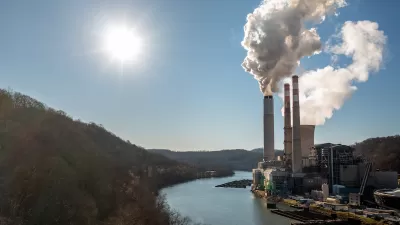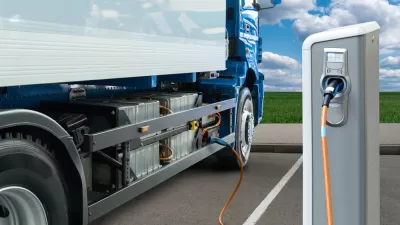The traditional approach for federal fuel economy and emissions standards is for the U.S. Department of Transportation and the Environmental Protection Agency to propose regulations simultaneously. This year is different.

On July 28, the U.S. Department of Transportation’s National Highway Traffic Safety Administration (NHTSA) released a proposal to update fuel economy standards for passenger cars and light trucks, with the preferred alternative “potentially reaching an average fleet fuel economy of 58 miles per gallon by 2032.”
The proposed rule sets targets that are consistent with Congress’ direction to conserve fuel and promote American energy independence and American auto manufacturing, while providing flexibility to industry on how to achieve those targets.
Though NHTSA does not take electric and other alternative fuels into account in setting the standards, manufacturers may use all available technologies – including advanced internal combustion engines, hybrid technologies and electric vehicles – for compliance.
However, most “[a]nalysts project that in order for automakers to achieve that average, roughly two-thirds of the new cars they sell by that year would have to be all-electric,” wrote Coral Davenport, an energy and environment reporter for The New York Times, in the source article.
On August 5, 2021, President Biden signed an executive order “setting a goal that 50 percent of all new passenger cars and light trucks sold in 2030 be zero-emission vehicles.”
Emissions standards pathway
In April, Davenport reported (via Planetizen) on the Environmental Protection Agency's proposal based on emission standards, not fuel economy rules, “designed to ensure that 67 percent of sales of new light-duty passenger vehicles, from sedans to pickup trucks, will be all-electric by 2032.”
As noted in in that post, the “proposed regulations will surely face legal challenges from those who see them as government overreach.”
In fact, that overreach by federal regulatory agencies was the central reason behind the U.S. Supreme Court's landmark decision last June that nullified the Obama-Biden administration's Clean Power Plan.
Belt and suspenders approach
“Legal experts say the two measures might also work in tandem to defend the administration’s climate policies against an expected wave of legal challenges,” added Davenport. “If the courts strike down one, the other might remain standing.”
Michael Gerrard, an environmental law expert at Columbia University, called it a “belt and suspenders” approach to achieving the administration's goal to transitioning the American auto fleet from being powered by internal combustion engines to largely electric batteries.
“The fact that we have two different rules from two different agencies under two different statutes increases the odds that at least one will survive.”
Legal challenges mount
“The auto industry’s largest lobbying group has already come out against the E.P.A.’s portion of the rules, writing in public comments on the proposal that major auto companies do 'not believe they can be met without substantially increasing the cost of vehicles, reducing consumer choice, and disadvantaging major portions of the United States populationand territory,'” added Davenport.
And the nation’s Republican attorneys general, who have banded together to challenge many other climate rules in court, are expected to do the same with the auto rules.
Davenport wrote about the effectiveness of those attorneys general on June 19, 2022, just over a week before they won the landmark climate case, West Virginia v. EPA.
Of the 27 Republican attorneys general, a core group from fossil fuel states is leading the coordinated legal challenges: Patrick Morrisey of West Virginia, Daniel Cameron of Kentucky, Todd Rokita of Indiana, Ken Paxton of Texas and Mr. Landry from Louisiana.
They meet regularly among themselves and with the oil, gas and coal industries, Mr. Landry said in an interview. “It would be great if we could see an overturning of Chevron,” he said.
“Chevron" is shorthand for Chevron U.S.A., Inc. v. Natural Resources Defense Council, Inc. (1984).
POLITICO reported on May 1 that the U.S. Supreme Court would be “taking up a case squarely aimed at killing off the nearly-four-decade-old precedent that has come to be known as Chevron deference: the principle that courts should defer to reasonable agency interpretations of ambiguous provisions in congressional statutes and judges should refrain from crafting their own reading of the laws.”
Additional reading: “GOP readies fight against new fuel economy standards,” Roll Call, Aug. 1, 2023.
Hat tip to Kenyon Karl (Sierra Club's Clean Transportation for All forum).
FULL STORY: Biden Administration Moves to Tighten Fuel Economy Rules

Trump Administration Could Effectively End Housing Voucher Program
Federal officials are eyeing major cuts to the Section 8 program that helps millions of low-income households pay rent.

Planetizen Federal Action Tracker
A weekly monitor of how Trump’s orders and actions are impacting planners and planning in America.

Ken Jennings Launches Transit Web Series
The Jeopardy champ wants you to ride public transit.

Rebuilding Smarter: How LA County Is Guiding Fire-Ravaged Communities Toward Resilience
Los Angeles County is leading a coordinated effort to help fire-impacted communities rebuild with resilience by providing recovery resources, promoting fire-wise design, and aligning reconstruction with broader sustainability and climate goals.

When Borders Blur: Regional Collaboration in Action
As regional challenges outgrow city boundaries, “When Borders Blur” explores how cross-jurisdictional collaboration can drive smarter, more resilient urban planning, sharing real-world lessons from thriving partnerships across North America.

Philadelphia Is Expanding its Network of Roundabouts
Roundabouts are widely shown to decrease traffic speed, reduce congestion, and improve efficiency.
Urban Design for Planners 1: Software Tools
This six-course series explores essential urban design concepts using open source software and equips planners with the tools they need to participate fully in the urban design process.
Planning for Universal Design
Learn the tools for implementing Universal Design in planning regulations.
Ada County Highway District
Clanton & Associates, Inc.
Jessamine County Fiscal Court
Institute for Housing and Urban Development Studies (IHS)
City of Grandview
Harvard GSD Executive Education
Toledo-Lucas County Plan Commissions
Salt Lake City
NYU Wagner Graduate School of Public Service




























